3.6K
About two weeks ago, I decided to go to Ein Gedi Nature Reserve, the lowest desert oasis in the world, a place full of water and beautiful desert views. Since I’m not too fond of driving, I decided to get there by bus. It was easier than I imagined. I even had extra time to take another bus to Masada before returning to Jerusalem. In this post, I’ll tell you about what you can do in the Ein Gedi Reserve.
But before I begin, I want to clarify something. When I got off the bus and started walking towards Ein Gedi Nature Reserve, I met some tourists who asked me if this was the way to Ein Gedi Beach. So… If you’re planning to get to Ein Gedi Beach, too, I recommend changing your plans. The beach is closed because of sinkholes, and I believe it will not open anytime soon. A better option would be to go to the Ein Bokek free beach or try out Kalia Beach, and both are not near the Ein Gedi Nature Reserve.
Now that we have that covered, let’s talk about the reserve.
Disclaimer: This page may include affiliate links that help me maintain the site. When you buy something through these links, I get a commission. It does not cost more for you.
How to get to Ein Gedi Nature Reserve?
Ein Gedi Nature Reserve is in the Judean Desert, next to the Dead Sea. It’s about a 1-hour drive from Jerusalem, so many people combine it in a day tour from Jerusalem. It would take about 2 hours from Tel Aviv, so it’s less recommended to depart there.
I visited Ein Gedi Nature Reserve by public transportation. I took bus number 486 from the Central Bus Station in Jerusalem (platform 4) and, after about one hour and 10 minutes, got off at the “Ein Gedi Reservation” station. Usually, the stations also show up in English on the screen inside the bus, so don’t worry. But if you want, you can also ask the driver to let you know before you arrive.
From the bus station, it’s a short 2-minutes walk to the reserve. Just walk to the west, and you’ll see the sign to Ein Gedi Nature Reserve.
So, getting there by public transportation is very easy from Jerusalem. The only problem is that the bus is not very frequent and only comes every hour, so you have to plan your time if you don’t want to wait an hour at the station.
If you’re coming by car, it’s very easy, too. Drive down road number 1 to the east, then turn south to road number 90, and continue until you reach the Ein Gedi Reserve parking lot. Parking is free-of-charge.
What is the meaning of Ein Gedi?
It’s always nice to know what a name means. So what does “Ein Gedi” mean? “Ein” means “water spring.” “Gedi” means the baby of the ibex or the wild goat. So, Ein Gedi is the water spring of the baby ibex. The name fits the place because it is the living area of the Nubian ibex. In the mid-20th century, the Nubian ibex almost became extinct because of local Bedouins’ hunting. But luckily, since the end of the 1950s, following the wildlife conservation law, the number of Nubian Ibexes has risen significantly. Hunting is no longer allowed, and some Nubian ibexes were also brought from Jordan. Today, there are about 2,000 ibexes in Ein Gedi. If you’re lucky, you might see them!
What can you do in Ein Gedi Nature Reserve?
There are several options at the reserve:
- The most popular option – and the option I’ll be talking about – was to hike up to the David Waterfall and return to the entrance. This trail is circular and takes about 1 hour.
- The longer option – is a longer hike that includes Ein Shulamit and some archeological findings. I did it a few years ago with my tour guide course, and it was excellent. If you have 3 to 4 hours, it’s a beautiful trail.
- Hiking Nahal Arugot – The Nahal Arugot wadi is part of the Ein Gedi Nature Reserve but has a separate entrance. It’s a beautiful and lesser-known part of the reserve, with lots of water and small waterfalls. It takes about 4 hours. If you have a car, you can easily drive there. If you’re on foot, it’s about a 25 minutes walk from the bus station. You need to continue south on the road and then turn onto a gravel road toward Nahal Arugot.
- Visiting the ancient synagogue – There’s an ancient 6th-century synagogue in Ein Gedi with a separate entrance and separate entry fees (14 ILS per person). Personally, I think the entrance fee is too much compared to what you see. If you’re planning to visit other ancient synagogues in Israel, like the Hamat Tiberias Synagogue, Ancient Tzippori Synagogue, or the Beit Alfa Synagogue, you can skip this one.
Important to note
- The hike is under your full responsibility, so please be careful while hiking.
- Make sure to bring shoes comfortable for walking in water, at least 2 liters of water, and a hat. If there’s a lot of sun, put on some sunscreen, too.
- There’s drinking water at the entrance, so you can fill your bottle before and after the trip.
- The trail is part of the Ein Gedi Nature Reserve, so check their website for opening hours and prices. It is required to reserve your visit in advance through the website.
- While the reserve will likely be closed in severe weather, it is important to check the weather forecast before coming. Because this is a water trail, it’s a good idea to come when it’s a bit hot, but not too much.
- In summer, the reserve will probably be packed with people. So, if you want to avoid the crowds, try coming in shoulder seasons such as the fall (October-November) or early spring (February-March). The temperature may be colder, but if it’s not too cold, it’s a good time to come.
The short hike in Ein Gedi Nature Reserve
I’ve done all the other options, but since the short hike to Lower David Waterfall is the most popular, I’ll focus on that. The short hike is lovely. It passes by the cliffs of Ein Gedi, some desert vegetation, and beautiful waterfalls. It starts and ends at the reserve’s entrance and takes about 1 hour, depending on your pace and the time you spend in the natural pools. There are many stairs on the way, so keep that in mind, too!
You can view the trail here.
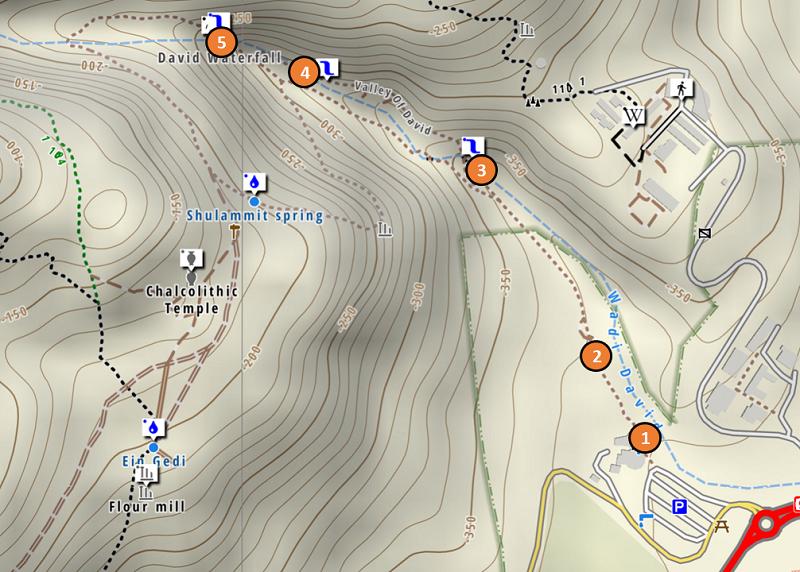
The park’s wildlife
I started from the entrance to the reserve (1). Right after the cashier, there are beautiful photographs on the wall showing the animals you might encounter in the reservation. You can also see animals that once roamed here and no longer exist, like the Judean Desert leopards. The most common animals are the Nubian ibexes and the rock hyraxes. I’ve seen them in the past, but when I visited last time, I didn’t see any animals. Maybe you’ll be luckier.
After passing the photographs, I started walking on a path that goes between a variety of desert trees. Each tree has a sign next to it showing the tree’s name. Right next to the entrance, there’s the umbrella thorn acacia, one of the most common trees in the Israeli desert. It thrives in the heat of the desert and gets along with the salty ground in the Dead Sea area. In the Bible, it says that the Tabernacle was partly made from the wood of the acacias. It makes sense since the Israelites were walking in the desert, and most likely, that was one of the most common trees they had.
Another interesting tree is the Toothbrush Tree, a bit farther ahead on the path. It is known as a natural toothbrush. All you need to do is take a thin branch, break its edge with a stone, and then use it as a toothbrush. Of course, please don’t do it at the reserve! But if you happen to get stuck in the desert without a toothbrush, you can look for the Toothbrush Tree. Legend tells that the prophet Muhammed used this tree to brush his teeth, a myth that turned the tree holy for Muslims.
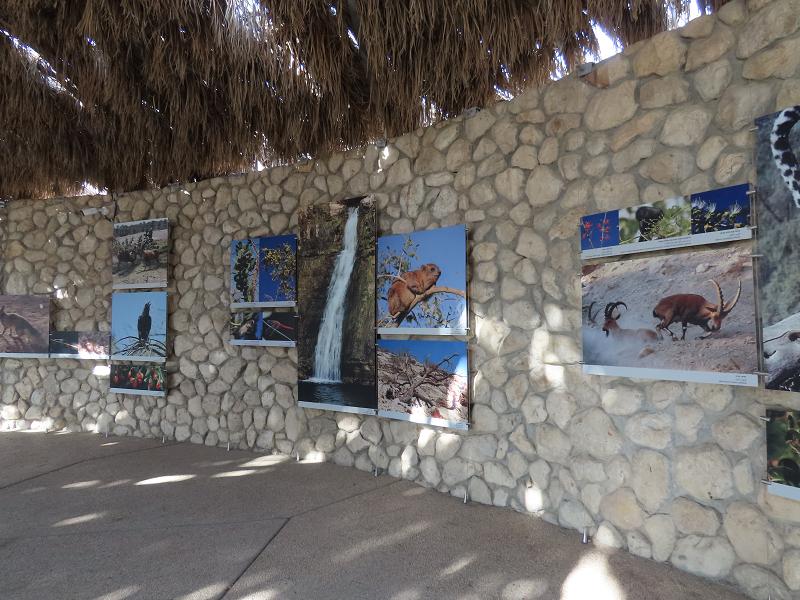
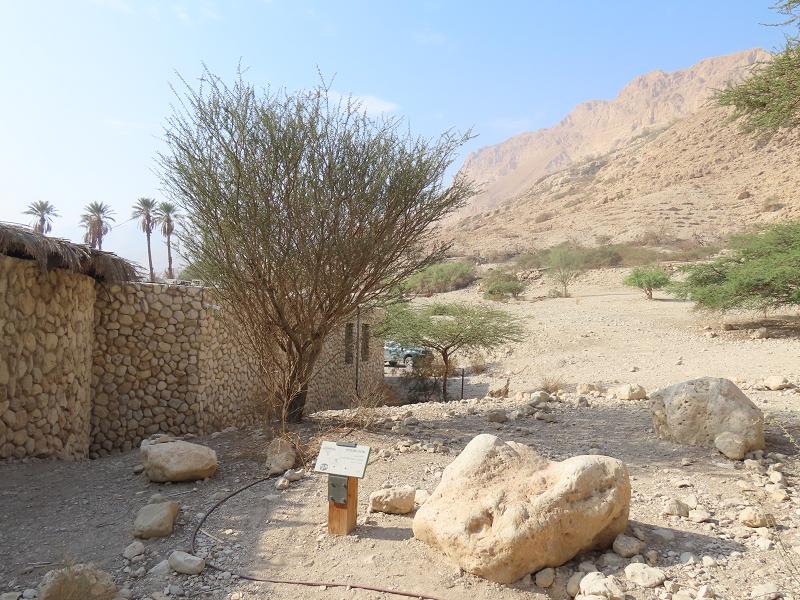
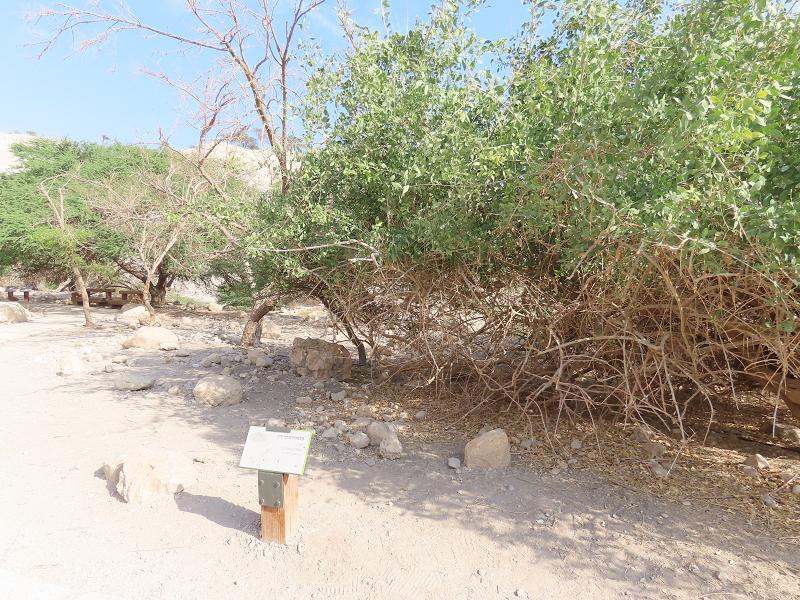
The Ibex Observation Memorial
After passing the path of trees, there was a left-hand turn toward the Ibex Observation Memorial (2). You don’t have to go up there. It’s also possible to continue straight on the trail. But I wanted to see what was up there, so I went on the short path to the memorial. According to the sign, it was built to remember the fallen sons of the Druze community who fought in the Israeli Defense Forces. In the early years of the State of Israel, many Druze served in the country’s southern regions, helped protect the border with Jordan, and carried out complex projects such as building the infrastructure for the Dead Sea Works. Many Druze were killed during clashes with terrorists who crossed the border from Jordan.
The memorial is a viewpoint from where you can see animals like the ibex and the local birds. I didn’t see anything.
The Lower David Waterfall
After visiting the memorial, I returned to the main trail. To the right, there are the beautiful cliffs of Nahal David, the main stream that passes through the reserve. In the past, the ground level was much higher, so people could use the caves on the cliff. Today, it is too far up. Legend says David hid in one of those caves while fleeing King Saul. According to the Biblical story, Saul wasn’t happy that everybody loved David more than they loved him, got jealous, and planned to kill David. So, according to legend, David hid here. One day, Saul arrived at Ein Gedi, too, and went to the restroom in one of the caves, which was, by accident, the same cave where David hid. David didn’t kill him, although he was in a vulnerable condition, and instead, they agreed to put the past behind them and not kill each other.
About 200 meters from there, I reached the first waterfall, the Lower David Waterfall (3). It’s a small waterfall with a wooden observation deck, the only one accessible for wheelchairs and strollers. There’s also an option to go down to the natural pool next to the waterfall.
Nahal David is dry in its upper part but full of water in its lower part thanks to four water springs that emerge from the ground. The nearby kibbutz of Ein Gedi used the water of the springs to establish their mineral water factory in the 1990s after their other sources of income were abandoned due to sinkholes. In the past, the kibbutz took too much water from the reserve, making it die. Luckily, the Israeli Nature and Parks Authority came into the picture and limited the amount of water they could take. Now we can enjoy the excellent water.
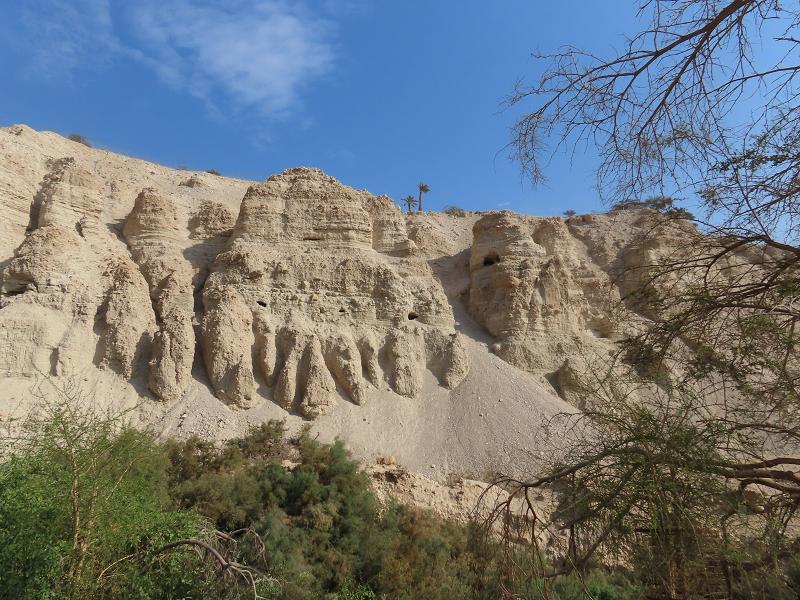

Climbing to the Upper David Waterfall
Just before the waterfall, there are steps going up. I followed the sign and made my way up the wadi. After about 70 meters, I crossed the stream on a wooden bridge. Then, the trail continued climbing for a while.
At some point, there’s a sign to the left saying “The Wet Trail.” You don’t have to do it, but it’s really fun, short, and circular, so you’ll return to the same spot. Water shoes are recommended. The Wet Trail takes you into the David Stream, which reaches the ankle. It passes a small waterfall that leads to a beautiful pool and then takes you up with hand and feet bars at another fantastic pool. There, the water is higher and there’s a beautiful waterfall. If you’re traveling with children, they’ll love it, as long as they’re ok with rock climbing a bit.

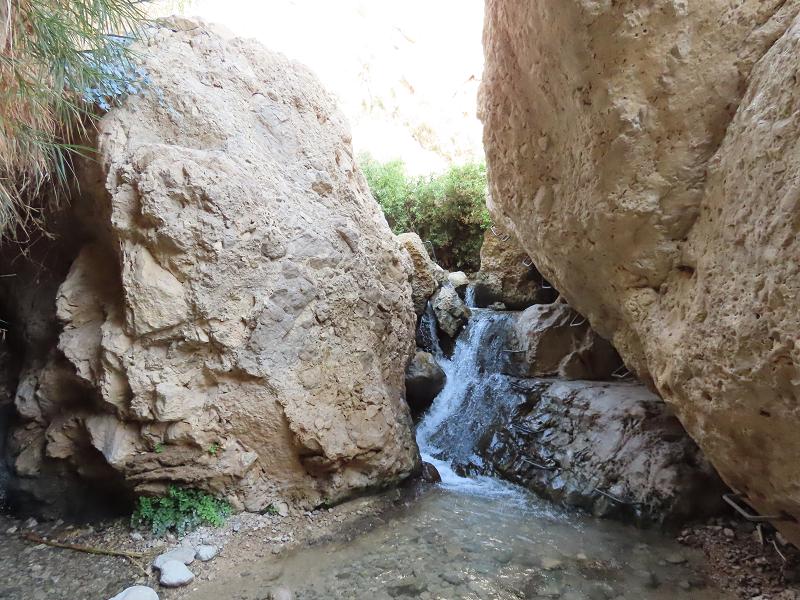
I came in a time when there were barely any people, so I had the pool all for myself. It was so much fun. After enjoying the water for a while, I continued on the trail, which continued upwards on many steps.
After a while, I reached another bridge crossing the stream (4). To the right, there’s another nice pool and small waterfalls. I didn’t spend too much time there and continued on the trail, which took me through a charming, shaded tunnel covered by stream-side plants. Right after the shaded tunnel, there was a small pool with another waterfall, but I continued upwards toward the Upper David Waterfall (5). There’s a trail junction. The right turn takes to the waterfall and the left turn to the exit.
The Upper David Waterfall is splendid and is the tallest waterfall in Nahal David. Because there were incidents of rocks falling off from the top of the waterfall and killing people, it is not allowed to get close to the waterfall. So, enjoy it from a safe distance!
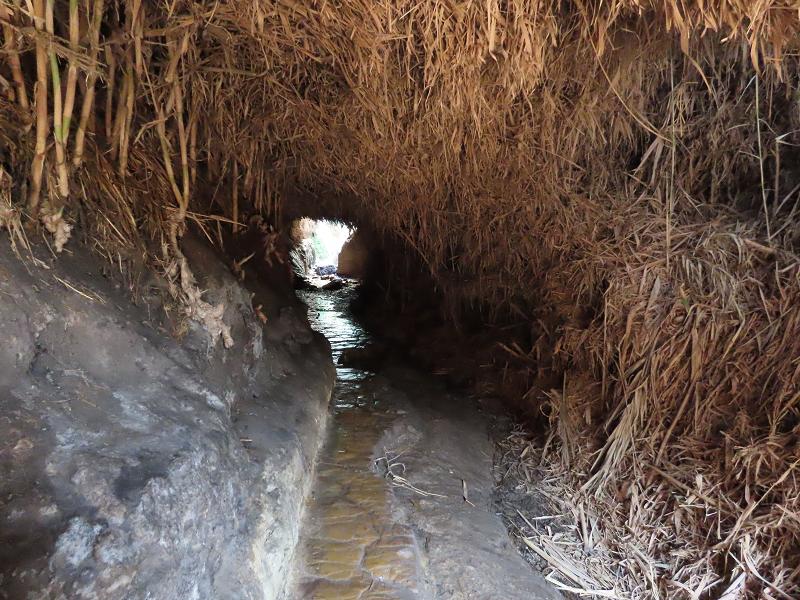

Back to the park’s entrance
After I enjoyed the beautiful view of the waterfall, I made my way back to the entrance. So, I returned to the trail junction and followed the arrow pointing toward the exit. Close by, there’s also a trail junction, where you can take the trail up to the longer trail in the reserve.
The way back goes on the other side of Nahal David but looks quite the same as the way to the David Waterfall. It also passes a shaded tunnel, and there are some small waterfalls on the way. Eventually, it reconnects to the main trail near the Lower David Waterfall. Then, it’s a short walk to the park’s entrance.
Where can you stay in the area?
If you want to stay in the area to see more of the Judean Desert, there are several options:
- Kibbutz Ein Gedi: To the south of the Ein Gedi Nature Reserve, there’s Kibbutz Ein Gedi. There are several camping options there like Ein Gedi Camp Lodge and Badolina Ein Gedi Glamping. There’s also the Ein Gedi Hotel if you have the budget. I didn’t stay in any of them, but I see they have good reviews, and Ein Gedi is easily accessible by public transportation.
- HI Ein Gedi Hostel: Right next to the Ein Gedi Nature Reserve, there’s the HI Ein Gedi Hostel. I stayed there many years ago when I was on some type of field trip. It was great at the time, and it seems like it still is a good place to stay based on the reviews.
- Ein Bokek: About 25 minutes by car and 40 minutes by bus is the Ein Bokek Resort Area. There’s an option to camp near the Dead Sea beach for free there, in the designated area next to the main traffic circle. There are also many hotels. You can read more about the Ein Bokek Resort Area here.
Conclusion
Ein Gedi Nature Reserve is a beautiful desert oasis and one of the most popular hiking trails in Israel. If you’re traveling to the Dead Sea area in a pleasant season and like natural places, this could be a great place to add to your list. In one hour, you can really appreciate this place’s beauty!
Save this post for later!
Visited the reserve in December 2022.
Think this post is useful or helpful? Don’t forget to like, share and leave a comment 🙂
Also, check out my Facebook page, Backpack Israel.
Yours,
Lior

